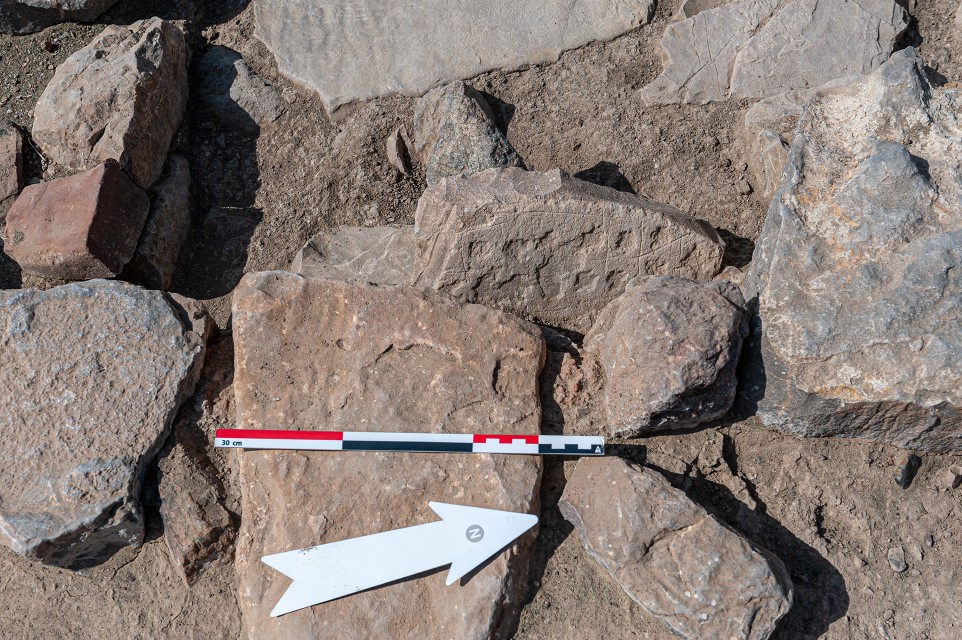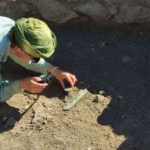At the end of December, another season of archaeological fieldwork in Qumayrah Valley in Northern Oman came to a close. Archaeologists identified there another tower in a Bronze Age settlement, unearthed evidence of copper smelting and discovered a 4 thousand-year-old… game board!
The work is carried out by an Omani-Polish project “The development of settlement in the mountains of northern Oman in the Bronze and Iron Ages” headed jointly by Prof. Piotr Bieliński from the Polish Centre of Mediterranean Archaeology, University of Warsaw (PCMA UW) and Dr. Sultan al-Bakri, Director General of Antiquities at the Ministry of Heritage and Tourism (MHT) of the Sultanate of Oman. It investigates the development and forms of settlement in one of the least studied corners of Oman: the mountain valleys of the Northern Hajar range.
In the current season, settlements from the Umm an-Nar phase of the Bronze Age and Iron Age II situated near the village of Ayn Bani Saidah were the main focus of the team’s work. – Ayn Bani Saidah is strategically located at a junction of routes connecting Bat in the south, Buraimi and Al-Ayn in the north, and the sea coast near Sohar in the east. Along this route there are some major sites from the Umm an-Nar period. So we hoped that also our site will be in the same league, – explains Prof. Bieliński.
Latest discoveries prove the archaeologists right. – The settlement is exceptional for including at least four towers: three round ones and an angular one. One of the round towers had not been visible on the surface despite its large size of up to 20 m in diameter. It was only discovered during excavations, – says Dr. Agnieszka Pieńkowska of the PCMA UW who is analyzing the Bronze Age remains within the project. – The function of these prominent structures present at many Umm an-Nar sites still needs to be explained, – she adds.
But new discoveries have also been made in other Bronze Age buildings. – We finally found proof of copper working at the site, as well as some copper objects. This shows that our settlement participated in the lucrative copper trade for which Oman was famous at that time, with mentions of Omani copper present in the cuneiform texts from Mesopotamia, – says Prof. Bieliński.
But the most unexpected discovery is not related directly to economy or subsistence. – In one of the rooms we’ve found… a game-board! – beams the project director. The board is made of stone and has marked fields and cup-holes. Games based on similar principles were played during the Bronze Age in many economic and cultural centers of that age. – Such finds are rare, but several examples are known from India, Mesopotamia and even the Eastern Mediterranean basin. The most famous example of a game-board based on a similar principle is the one from the graves from Ur, – explains the archaeologist.
Next year, the team will continue work in the Qumayrah Valley, both in Ayn Bani Saidah and in Bilt, on the other end of the valley where further Umm an-Nar remains are located.
- The project “The development of settlement in the mountains of northern Oman in the Bronze and Iron Ages” is financed with a grant from the Polish National Science Centre (2018/30/M/HS3/00635).
- Read about the Omani-Polish Archaeological Mission: https://pcma.uw.edu.pl/en/2019/02/07/qumayrah-ayn-2/
- Read the press release (PDF)
-
1. Czyszczenie murów budynku z okresu Umm an-Nar / Cleaning the walls of an Umm an-Nar building (photo J. Sliwa/PCMA UW)
-
2. Odsłanianie pozostałości z epoki żelaza i epoki brązu / Excavating the Iron and Bronze Age remains (photo J. Sliwa/PCMA UW)
-
3. Prace pomiarowe / Surveying work (photo J. Sliwa/PCMA UW)
-
4. Pozostałości osady z epoki żelaza zajmują rozległy teren / Iron Age remains are spread over a vast area (photo J. Sliwa/PCMA UW)
-
5. Przedmioty miedziane / Copper objects (photo G. Czajka/PCMA UW)
-
6. Plansza do gry z Ayn Bani Saidah w miejscu znalezienia / Game-board from Ayn Bani Saidah in situ during exploration (photo J. Sliwa-PCMA UW)







